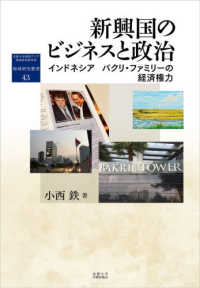- ホーム
- > 洋書
- > 英文書
- > Architecture
Full Description
Between 1918 and 1933 the German interwar avant-garde was a primary force driving European cultural innovation and modernism. These innovations continue to influence artistic practice, theory, and arts education today, thus making a comprehensive study of the relationship between individual war experience and the immediate response of avant-garde architects after the war all the more important.
The Break with the Past pursues several important, interrelated questions. What were the disparate war experiences of German architects, and did they have different effects on Weimar cultural production? Did political orientation play a part in support for the war? In aesthetic choices? What changes occurred in avant-garde architectural practice after 1918? How do they compare with pre-war positions and practices, and expectations for post-war outcomes? In order to address these questions, the book uses individual case studies of four leading architects: Bruno Taut, Walter Gropius, Erich Mendelsohn, and Hans Scharoun.
This is a valuable resource for academics and students in the areas of Art and Architecture History, German history and Cultural Studies, European Culture and Modernism.
Contents
Introduction: Architecture in Transition: Germany's Avant-garde before the First World I and the Weimar Republic
Bruno Taut: Before the War
Bruno Taut: War Years Resistance
Bruno Taut: Leading the Avant-garde
Walter Gropius: Career Beginnings
Walter Gropius: War Service on the Western Front
Walter Gropius: Rise to Prominence
Erich Mendelsohn: Born Revolutionary
Erich Mendelsohn: The War Years
Erich Mendelsohn: After the War
Hans Scharoun: Bremen and Berlin
Hans Scharoun: On the Eastern Front
Hans Scharoun: The Interwar Years
Art and the Revolution






